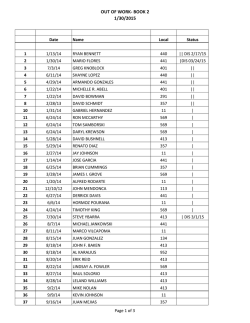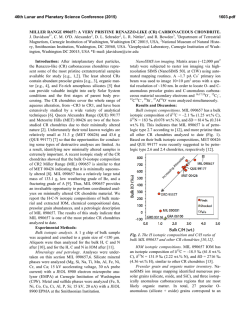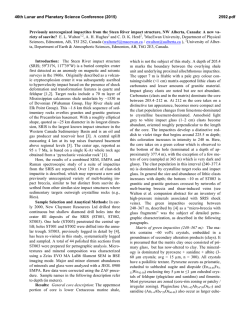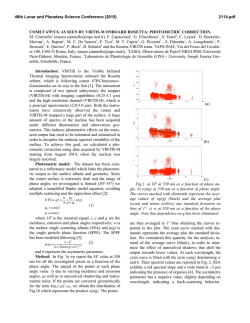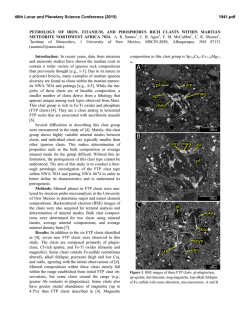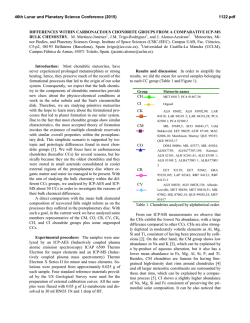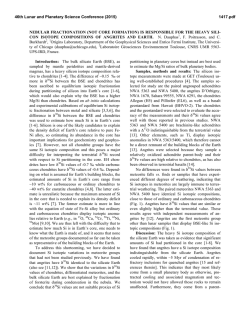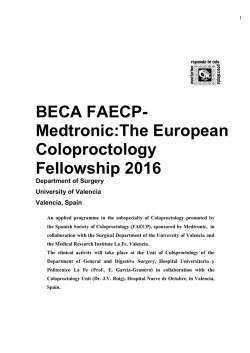
THE OXYGEN ISOTOPE COMPOSITION OF DARK - USRA
46th Lunar and Planetary Science Conference (2015) 2975.pdf THE OXYGEN ISOTOPE COMPOSITION OF DARK INCLUSIONS IN HEDs, ORDINARY AND CARBONACEOUS CHONDRITES. R. C. Greenwood1, M. E. Zolensky2, P.C. Buchanan3, I.A. Franchi1. 1 Planetary and Space Sciences, The Open University, Milton Keynes MK7 6AA, UK ([email protected]). 2 ARES, Johnson Space Center, Houston TX, USA.3Kilgore College, Kilgore, Texas 75662 USA. Introduction: Dark inclusions (DIs) are lithic fragments that form a volumetrically small, but important, component in carbonaceous chondrites [1,2]. Carbonaceous clasts similar to DIs are also found in some ordinary chondrites and HEDs [3,4]. DIs are of particular interest because they provide a record of nebular and planetary processes distinct from that of their host meteorite [1,5]. DIs may be representative of the material that delivered water and other volatiles to early Earth as a late veneer [6]. Here we focus on the oxygen isotopic composition of DIs in a variety of settings with the aim of understanding their formational history and relationship to the enclosing host meteorite. Materials and methods: DIs and related materials were obtained from the following meteorites: CV3s (Allende, NWA 2140, NWA 2364): Samples from Allende cover all categories of the four-fold classification scheme [2] (inclusion numbers analyzed in brackets). Type A clasts (1a1, 4b1, 25s1-TW1) contain chondrules, inclusions and matrix, but are somewhat finer grained than normal Allende material. Type A/B clasts (MZB) are transitional between Types A and B (Fig. 1). Type B clasts (12b1) contain opaque matrix and olivine-rich aggregates and may have experienced a hydration-dehydration cycle [2]. Type C clasts (5a1, ekpb4b1, MZ15, USNM 3876) consist of fine-grained, opaque material similar to Allende matrix. Full descriptions for of the Allende DI samples are given in [2]. DI material from NWA 2140 analyzed for this study is Type A/B and Type A for NWA 2364. HEDs: (Bholghati, PRA 04401, SCO 06040). DIs from the howardite Bholghati have not been analyzed by us for oxygen isotopes. Instead a sequence of 5-10 mg representative whole rock samples have been run to assess its carbonaceous chondrite content. PRA 04401 is an extremely coarse-grained howardite containing a high concentration (~40-50% in places) of nearly cm-sized angular carbonaceous clasts that texturally resemble CM2 material [7]. SCO 06040 is also a coarse-grained howardite breccia, contains a lower amount (~10%) of rounded, up to 2mm diameter, CM2-like clasts [7]. OCs: Sharps (H3.4) is a fragmental breccia containing accessory carbonaceous clasts up to 1 cm in diameter [8]. Oxygen isotope analysis was performed by infrared laser-assisted fluorination [9]. All analyses were obtained on untreated whole rock samples (0.5-2 mg). System precision, as determined on an internal obsidi- an standard is: ±0.05‰ for δ17O; ±0.09‰ for δ18O; ±0.02‰ for 17O (2σ). Fig. 1 Mg Map of a Type A/B Allende clast (AMNH 4301 [1]). Remnants of primary material are present in the centre of some larger chondrules. Results: All of the Allende DIs are displaced slightly to the right of the CCAM line in Fig.2 and define a linear trend with a slope of y = -4.30 + 0.89x R2 = 0.99. The less altered chondrule-bearing clasts (A and A/B) plot closest to bulk Allende analysis in Fig. 2, with the most altered clast (Type B) (12b1) being approximately 5‰ heavier with respect to 18O. Matrixrich Type C clasts show a narrow range of oxygen isotope variation, plotting roughly halfway between the most and least altered DIs in Fig. 2. These results are in agreement with previous studies of Allende DIs [1]. DIs in CV3s NWA 2140 and NWA 2364 (Type A/B and A respectively) plot at the higher δ18O values than their equivalents in Allende (Fig. 2). This is consistent with the results of previous studies [1] which found that Allende DIs are relatively 16O-enriched compared to inclusions in other CV3s (Fig.3). Carbonaceous chondrite clast material from the howardite PRA 04401 plots at the extension of the CM2 field in Fig. 2 consistent with results of textural and mineralogical studies [7]. The other howardite samples analyzed in this study (SCO 06040 and Bhol- 46th Lunar and Planetary Science Conference (2015) 2975.pdf ghati) have 17O values that vary from -0.265 to 0.489‰, consistent with bulk carbonaceous chondrite (CM2) contents of between about 1 and 10%. Fig. 3 Oxygen isotope composition of DIs in CV3 chondrites. Data this study and [1] (see text for details). Fig. 2 Oxygen isotopic composition of Dark Inclusions. The blue dashed line is the best fit line through the Allende DIs only. Bulk Allende [10]. TFL = Terrestrial Fractionation Line, CRML = CR Mixing Line [11], CCAM = Carbonaceous Chondrite Anhydrous Mineral line [12]. CM2 field (blue shading) [12], CV-CK field (grey shading) [10]. DIs analyzed in Sharps are clearly distinct from those in either the CV3s or howardites and plot on the CR Mixing Line [11]. The composition of these DIs is not well understood, although they do not appear to be mineralogically related to CR chondrites [8]. Discussion: Mineralogical studies of DIs have played a crucial role in highlighting the importance of parent body processes in modifying the composition of CV chondrites [2, 13]. In particular, DI studies have shown that CV3s, previously regarded as pristine nebular condensates, underwent extensive aqueous alteration [2, 13]. Furthermore, textural evidence indicates that, following aqueous alteration, some DIs experienced a phase of thermal metamorphism, resulting in phyllosilicate dehydration and the formation of secondary Fe-rich olivine (Type B inclusions) [13]. This model was later extended to explain the origin of CV3 Fe-rich matrix olivines in general [14]. The results of previous oxygen isotope studies of DIs have also pointed to the role of aqueous alteration in modifying their primary compositions [1]. As shown in this study, DIs define linear arrays with a shallower slope than the CCAM and with less altered material plotting at the 16O-rich end (Type As) and more altered material (Type Bs) at the 16O-poor end [1]. However, with respect to phyllosilicate dehydration and secondary Fe-rich olivine formation, oxygen isotope evidence appears less clear-cut [15]. Experimental evidence indicates that dehydration will result in heavy-isotope enrichments, which for Allende matrix olivines are not seen, if the CCAM line is used as a reference [15]. However, DIs in Allende may point to a possible weakness in this argument. In Fig. 2 and 3 DIs do not sit on the CCAM line, but instead define a line of lower slope (Fig. 2). In a similar way, chondrules in Allende plot on a discrete line with a steeper slope than the CCAM line. Analysis of 22 Allende chondrules (OU unpublished data) yield an array with a slope of: y = 3.45 + 0.97x (Fig. 3). If this reference line, rather than the CCAM, is used positive shifts of 7‰ along a mass fractionation line to the array defined by Vigarano DIs is feasible (Fig. 3). This is greater than required by earlier experiments [15]. More recent work has shown that shifts of 7‰ are produced during dehydration of serpentine [16]. Thus, phyllosilicate dehydration, leading to the formation of CV3 Fe-rich matrix olivines, may be a viable mechanism, provided the relevant reference line is steeper than the CCAM [17]. References: [1] Johnson C. A. et al. (1990) GCA, 54, 819-830. [2] Buchanan P. C. et al. (1997) GCA, 61, 1733-1743. [3] Zolensky M. E. et al. (1996) Meteoritics & Planet. Sci., 31, 518-537. [4] Zolensky M. E. et al. (1996) LPS XXVII, 1507-1508. [5] Weisberg M.K. et al. (1998) LPS XXIX, Absract #1882. [6] Gounelle M. et al. (2005) GCA 69, 3431-3443. [7] Herrin et al. (2011) LPS 42, abstract #2806. [8] Kebukawa Y. et al. (2012) MAPS 75, abstract#5085. [9] Miller M. F. et al. (1999) Rapid Commun. Mass Spectrom. 13, 1211-1217. [10] Greenwood R.C. et al. (2010) GCA 74, 1684-1705. [11] Schrader D.L. et al. (2011) GCA 75, 308-325. [12] Clayton R.N. and Mayeda T.K. (1999) GCA 63, 2089-2104. [13] Kojima T. and Tomeoka K. (1994) Meteoritics 29, 484 (absr.). [14] Krot A. N. et al. (1995) Meteoritics 30, 748 abstrct. [15] Mayeda T.K. and Clayton R.N. (1998) LPS XXIX abstract #1405. [16] Ivanova et al. (2013) Meteoritics & Planet. Sci. 48, 2059-2070. [17] Young E.D. and Russell S. S. (1998) Science 282, 452-455.
© Copyright 2025
